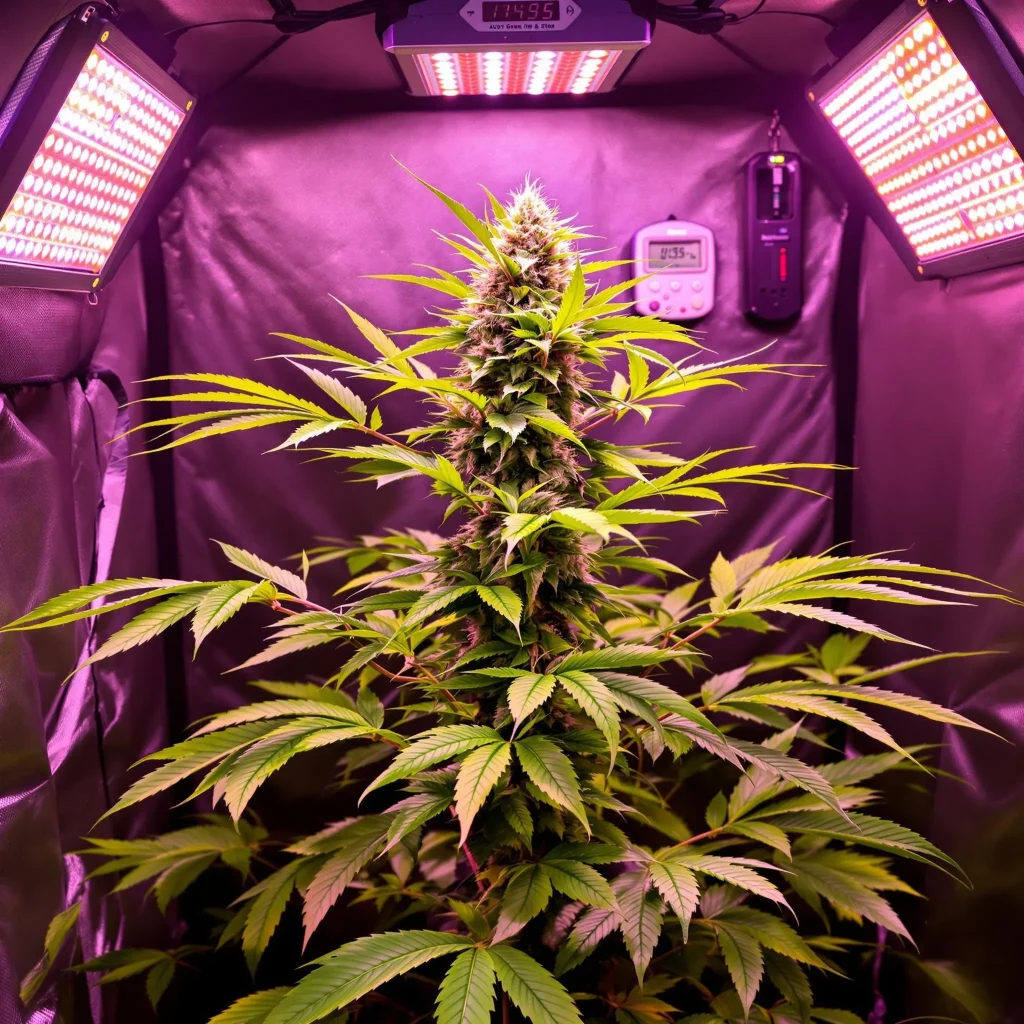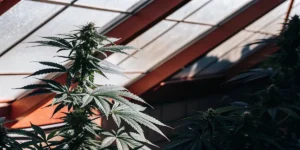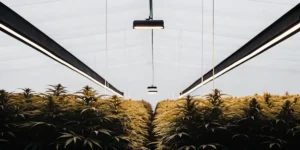Autoflower Light Intensity
What Is Light Intensity and Why Does It Matter for Autoflowers?
Autoflower Light Intensity for cannabis strains are unique in their ability to flower without depending on light cycles. However, knowing and optimizing light intensity is crucial to achieving the best results. Light intensity refers to the amount of light energy reaching your plants and directly impacts photosynthesis, which fuels growth and development. Getting it right ensures healthier plants and higher yields.
For autoflowers, the correct light intensity can mean the difference between mediocre and outstanding results. It’s important to provide balanced lighting throughout all growth stages, as too much or too little light can stress plants and hinder their development. Growers must carefully monitor and adjust light intensity to meet the specific needs of their plants.
How Light Intensity Affects Cannabis Growth Stages
Each growth stage of an autoflower requires specific light intensities to promote optimal development. During the seedling phase, gentle light is necessary to nurture delicate sprouts without overwhelming them. As the plants enter the vegetative stage, higher light intensity encourages vigorous foliage and root development, laying the foundation for a successful flowering period.
In the flowering stage, strong light intensity supports dense bud formation and trichome production, enhancing the strain’s potency and flavor profile. By tailoring light intensity to each stage, growers can maximize their plant’s potential and yield quality.
Optimal Light Intensity for Autoflowers
Recommended Light Levels in Seedling Stage
During the seedling phase, autoflowers need 200-400 PPFD to thrive. This range provides enough light to support early photosynthesis without stressing the young plants. Placing dimmable LED lights 18-24 inches above the canopy ensures even coverage. Excessive light can cause seedlings to stretch, while insufficient light results in weak and leggy growth. Autoflower light intensity should be increased gradually to prevent stress.
Maintaining a stable environment with moderate temperatures and proper humidity complements light intensity. Using reflective materials around your grow space can help maximize light efficiency, especially in small setups.
Vegetative Stage Light Intensity for Autoflowers
In the vegetative stage, autoflowers require 400-600 PPFD for optimal growth. This level promotes healthy leaves and sturdy stems, preparing the plant for flowering. Adjust the light distance to around 12-18 inches from the canopy and ensure the entire plant receives even light exposure.
Regularly monitoring plant responses to light is essential. Signs like drooping leaves or yellowing can indicate issues with intensity. Using a PAR meter can help measure light levels accurately, ensuring your plants remain within the recommended range.
Flowering Stage Light Intensity: Maximizing Bud Development
The flowering stage demands the highest light intensity, ranging from 600-900 PPFD. At this stage, strong light supports resin and trichome production, leading to potent buds. Lower light levels during flowering can result in airy buds with less potency, while excessive light can cause bleaching. Autoflower light intensity directly influences the density and quality of buds.
Position lights carefully to maintain consistent coverage across the canopy. For large grow spaces, consider using multiple light sources to eliminate shadowed areas. Proper airflow and humidity control also play a crucial role in preventing mold and other issues.
As autoflowers reach late flowering, growers often consider defoliation techniques to improve light penetration and airflow, ensuring optimal bud development. If you’re wondering whether it’s safe to defoliate your autoflowers in late flower, check out this guide on defoliating autoflowers in late flower for expert tips on maximizing yields while minimizing stress on your plants.
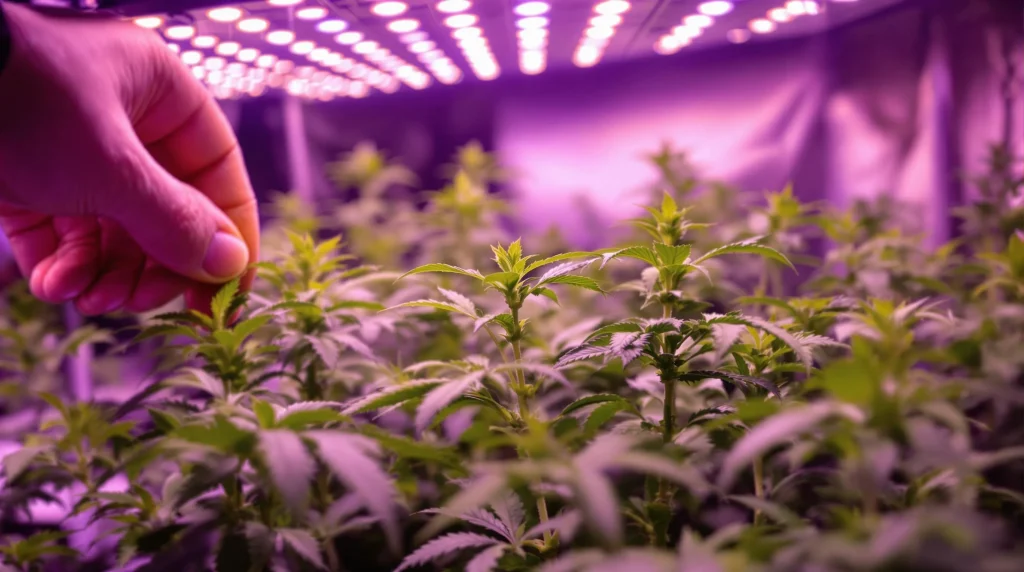
Choosing the Right Grow Lights for Autoflowers
Comparing LED, HID, and CFL Lights for Autoflowers
LED lights are the most popular choice for growing autoflowers due to their energy efficiency, long lifespan, and full-spectrum output. Choosing the right grow light is essential for providing optimal autoflower light intensity. They produce minimal heat, making them ideal for indoor setups. HID lights, such as HPS (High-Pressure Sodium) and MH (Metal Halide), provide strong light intensity but consume more energy and generate significant heat, requiring careful temperature management.
CFL (Compact Fluorescent Lamp) lights are affordable and easy to use but lack the intensity needed for high yields. While suitable for seedlings or small plants, CFLs may not provide enough power for mature autoflowers, especially during flowering.
For the best results, it’s also crucial to start with high-quality genetics. If you’re looking for top-tier strains with strong resilience and high yields, check out this guide on the best autoflower genetics to ensure your plants reach their full potential.
Full-Spectrum vs. Specific Wavelength Lights
Full-spectrum lights mimic natural sunlight, providing the wavelengths necessary for all growth stages. They simplify the growing process by eliminating the need to switch lights between vegetative and flowering phases. Autoflower light intensity is maximized when using full-spectrum LEDs, as they support both vegetative and flowering phases effectively. Lights with specific wavelengths, such as red for flowering and blue for vegetative growth, allow for targeted plant responses but may require adjustments as plants transition between stages.
Budget-Friendly Options for Autoflower Grow Lights
For growers on a budget, CFLs and entry-level LED lights offer affordable options for cultivating autoflowers. While these options may lack advanced features, they still provide sufficient light for successful growth. Pairing these lights with reflective surfaces enhances light distribution and efficiency.
Researching cost-effective grow lights with positive reviews helps beginners and hobbyists find the best solutions for their setups. Proper maintenance and positioning further maximize the value of budget-friendly lighting systems.
Adjusting Light Intensity for Maximum Yields
How to Measure and Monitor Light Intensity
Using a PAR (Photosynthetically Active Radiation) meter is the most accurate way to measure light intensity in your grow space. These devices provide precise PPFD readings, helping you adjust your lights to meet the plants’ needs. For smaller setups, smartphone apps or light meters can offer approximate measurements.
Regular monitoring ensures that light levels remain consistent, preventing fluctuations that could stress the plants. Combining measurements with visual inspections helps identify issues early, such as leaf discoloration or curling, which often indicate light-related problems.
Light Placement: Distance Between Lights and Plants
Proper light placement is vital for achieving optimal autoflower light intensity. Placing lights too close can cause heat stress and leaf burn, while positioning them too far reduces intensity and slows growth.
The distance between lights and plants greatly influences light intensity. For LEDs, maintaining a distance of 12-24 inches is generally recommended, depending on the light’s wattage and stage of growth. HID lights require greater distances due to higher heat output. Regularly inspect the plants for signs of stress, such as leaf curling or bleaching, and adjust the light distance accordingly. Rotating plants or repositioning lights can also help achieve uniform exposure across the canopy. Additionally, maintaining proper air circulation is essential in any grow setup. If you’re wondering whether you need an intake fan for your grow tent, check out this guide on maximizing cannabis yields with proper ventilation.
Signs Your Autoflowers Are Receiving Too Much or Too Little Light
Overexposure to light can cause symptoms like yellowing, leaf burn, or bleaching, while underexposure leads to slow growth and weak stems. Plants receiving insufficient light often exhibit elongated, spindly growth as they stretch toward the light source. Balancing light intensity with proper nutrient and water schedules ensures healthy growth. If issues arise, adjust the light placement or intensity and monitor the plants’ response over a few days.
Common Light-Related Mistakes in Autoflower Growing
Overexposure to Light and Its Impact on Plants
Excessive autoflower light intensity can cause irreversible damage to plants leading to issues like leaf burn, curling, and reduced photosynthesis. Overexposure also increases water and nutrient uptake demands, potentially causing deficiencies or toxicities. Regularly checking light intensity and adjusting placement minimizes these risks.
Dimmable lights allow growers to fine-tune intensity levels, ensuring plants receive adequate but not excessive light. Combining proper light intensity with optimal airflow and humidity prevents additional stress on the plants.
Underexposure and Slow Growth in Autoflowers
Insufficient light results in stunted growth, weak stems, and lower yields. Autoflowers have a fixed lifecycle, so even brief periods of inadequate light can significantly impact overall development. Ensuring plants receive at least 400 PPFD during vegetative growth and 600 PPFD during flowering is essential for optimal results.
Supplementing with additional light sources or repositioning lights improves light coverage. Consistent monitoring helps growers address underexposure and support healthy plant development.
Misunderstanding Photoperiod Needs for Autoflowers
Unlike photoperiod strains, autoflowers don’t depend on light schedules to flower. However, providing 18-24 hours of consistent light per day maximizes their growth potential. Shorter light periods reduce energy intake, leading to smaller plants and lower yields.
Growers transitioning from photoperiod plants may struggle with this adjustment, but knowing autoflowers’ unique requirements ensures successful cultivation.
Advanced Lighting Techniques for Autoflowers
Using Dimmable Lights for Precise Intensity Control
Dimmable LED lights allow growers to adjust light intensity as needed, reducing stress on plants during sensitive stages like seedling development. Gradual adjustments help avoid sudden changes that could negatively affect growth. Pairing dimmable lights with PAR meters ensures accurate measurements, allowing growers to fine-tune settings for optimal results. This technique is particularly useful in multi-strain setups where plants may have varying light needs.
Supplemental Lighting for Outdoor Autoflowers
Outdoor autoflower growers can use supplemental lighting to extend daylight hours or boost intensity during cloudy days. Portable LED lights or solar-powered solutions provide flexibility and ensure plants receive consistent light exposure. Supplemental lighting is especially beneficial in regions with unpredictable weather or shorter growing seasons. Combining natural and artificial light maximizes growth potential while maintaining cost-efficiency.
Light Schedules and Autoflowering Plants: Does Timing Matter?
While autoflowers don’t rely on light schedules for flowering, providing consistent light enhances their growth. An 18-6 schedule balances energy intake and rest periods, promoting healthy development. For maximum yields, some growers opt for 20-4 or even 24-hour light cycles. Experimenting with light schedules can help determine what works best for your strain and setup. Always monitor plant responses to ensure changes benefit overall growth and yield quality.
Monitoring plant responses to different light schedules helps optimize growth conditions. Balancing light intensity and duration ensures plants thrive and reach their full potential.
Strains for Autoflower Cultivation
Blackberry Moonrocks Auto
Blackberry Moonrocks Auto is a powerhouse strain renowned for its rich purple hues and high THC levels, often reaching up to 24%. This autoflowering variety thrives in controlled environments with proper autoflower light intensity to maximize resin production and terpene profiles. Expect a mix of sweet berry flavors combined with earthy undertones. Growers appreciate its resilience to pests and diseases, making it an excellent choice for both beginners and experienced cultivators. With a flowering time of just 8-10 weeks, this strain ensures a quick and rewarding harvest.
Orient Auto
Orient Auto is a compact strain perfect for indoor grows or discreet outdoor setups. Its genetics provide a harmonious balance between relaxation and euphoria, making it a favorite among medicinal users. To achieve its full potential, consistent autoflower light intensity is essential, especially during the vegetative phase. The strain’s flavor profile includes spicy and floral notes, reflecting its unique lineage. Orient Auto is also highly resistant to mold and mildew, ensuring a smooth cultivation experience even in less-than-ideal conditions. Flowering in just 9 weeks, it delivers generous yields for its size.
Sweety Auto
Sweety Auto lives up to its name with a deliciously sweet and citrusy aroma that fills the grow space. This strain is known for its rapid growth and impressive yields, even for novice growers. Proper autoflower light intensity plays a crucial role in enhancing its dense bud structure and vibrant terpene profile. Sweety Auto’s effects are uplifting yet relaxing, making it a versatile option for both day and nighttime use. Its short flowering period of 7-8 weeks ensures a fast turnaround, ideal for those looking to maximize their growing cycles.
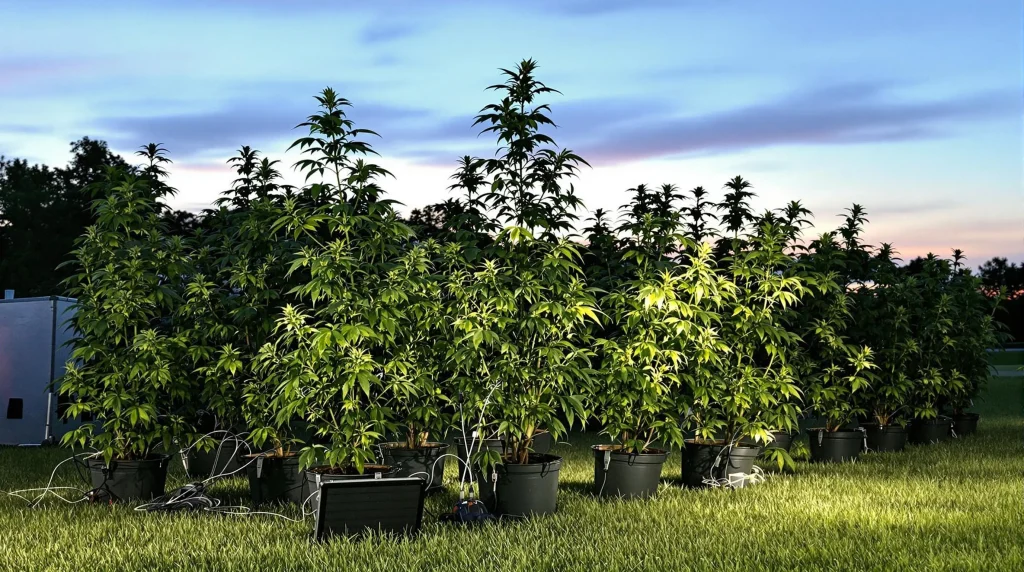
FAQs About Autoflower Light Intensity
How Many Hours of Light Do Autoflowers Need?
Autoflowers thrive with 18-24 hours of light daily. Extended light exposure maximizes photosynthesis, resulting in faster growth, higher yields, and potent buds. While 18 hours provides a balance of growth and energy efficiency, 20-24 hours may produce slightly better results for some strains.
Can Autoflowers Grow Without Optimal Light Intensity?
Yes, but suboptimal light intensity reduces growth rates, yield size, and bud quality. Ensuring proper light levels throughout the plant’s lifecycle is crucial for achieving its genetic potential. Even budget-friendly setups can produce impressive results with strategic adjustments.
Do Autoflowers Require the Same Intensity as Photoperiod Strains?
Autoflowers generally need slightly less light intensity than photoperiod plants, especially during early growth stages. However, their fixed lifecycle makes consistent light exposure critical. Matching light intensity to each growth stage ensures healthy development and maximum yields.

